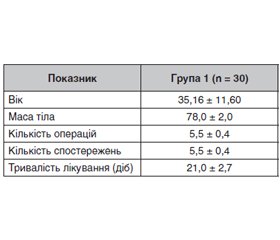Журнал «Медицина неотложных состояний» Том 19, №4, 2023
Вернуться к номеру
Особливості організації знеболювання опіоїдними аналгетиками в пацієнтів з фантомними болями після ампутації кінцівок унаслідок вогнепальних поранень
Авторы: Кучин Ю.Л. (1), Кузнецов А.Д. (1, 2), Гибало Р.В. (2), Слободянюк А.Т. (2), Мервінський Н.С. (2), Драч С.О. (2), Горошко В.Р. (1, 2)
(1) — Національний медичний університет імені О.О. Богомольця, м. Київ, Україна
(2) — Національний військово-медичний клінічний центр «Головний військовий клінічний госпіталь», м. Київ, Україна
Рубрики: Медицина неотложных состояний
Разделы: Клинические исследования
Версия для печати
Актуальність. З початком широкомасштабної війни на території України частота ушкоджень кінцівок становила 40 %, із них 15 % — це пацієнти з пораненням верхніх кінцівок і 25 % — нижніх кінцівок, значно зросла частка пацієнтів, які втратили кінцівки внаслідок поранень. У таких пацієнтів фантомний біль зустрічається в понад 60 % випадків. Такий біль надзвичайно складно піддається лікуванню стандартними підходами. Зазвичай лікування такого болю потребує призначення опіоїдних аналгетиків, проте немає даних щодо їх ефективності в комплексній терапії фантомного болю, який з’являється внаслідок ампутації кінцівки і є однією з найскладніших клінічних проблем сьогодення. Автори статті порівняли застосування оксикодону й трамадолу з метою визначення ефективнішого лікарського препарату. Мета роботи: вивчити ефективність трамадолу й оксикодону в таблетованих формах у комплексній терапії пацієнтів з фантомними болями після ампутації кінцівок унаслідок вогнепальних поранень. Матеріали та методи. У нашому дослідженні взяли участь 57 пацієнтів. Діагноз фантомного болю встановлювали на основі даних клінічної картини й опису пацієнта. Інтенсивність болю вивчали за допомогою візуальної аналогової шкали. Для визначення нейропатичного компонента болю використана шкала DN4 (Douleur Neuropathique en 4 questions). Для перевірки розподілу кількісних показників на нормальність використано критерій Шапіро — Уїлка і критерій Стьюдента. Результати. За даними візуальної аналогової шкали вірогідної статистичної різниці між групою 1 і 2 не виявлено (р > 0,05). Дані опитувальника DN4 вказують на те, що в групі 1 статистично результати кращі, ніж у групі 2 (р < 0,05). Висновки. Результати знеболювання пацієнтів з фантомними болями після ампутацій кінцівок унаслідок вогнепальних поранень свідчать про те, що застосування в комплексній терапії оксикодону дає кращий результат, ніж трамадолу.
Background. Since the beginning of the large-scale war on the territory of Ukraine, the incidence of limb injuries has reached 40 %: 15 % of them are upper limb injuries, 25 % are lower limb injuries, and the proportion of patients who have lost limbs due to trauma has increased significantly. In these patients, phantom pain occurs in more than 60 % of cases. Such pain is extremely difficult to treat with standard approaches. Usually, the prescription of opioid analgesics is required, but there is no data on their effectiveness in the comprehensive therapy of phantom pain, which appears as a result of limb amputation and is one of the most difficult clinical problems today. The authors of the article compared the use of oxycodone and tramadol to determine the most effective drug. The purpose was to study the efficacy of tramadol and oxycodone in tablet form in the comprehensive therapy of patients with phantom limb pain after amputation due to gunshot wounds. Materials and methods. Our study involved 57 patients. The diagnosis of phantom pain was made based on the clinical picture and patient description. The severity of pain was studied using the visual analog scale. To determine the neuropathic component of pain, Douleur Neuropathique 4 questions were used. The distribution of quantitative indicators for normality was checked with the Shapiro-Wilk test and Student’s test. Results. According to the visual analog scale data, no significant statistical difference was found between group 1 and 2 (p > 0.05). The data of Douleur Neuropathique 4 questions indicate that group 1 has statistically better results than group 2 (p < 0.05). Conclusions. The results of pain relief in patients with phantom limb pain after amputation due to gunshot wounds indicate that the use of oxycodone in comprehensive therapy shows a better result than tramadol.
лікування болю; етапи лікування; фантомний біль; вогнепальні поранення; мінно-вибухові поранення; опіоїдні аналгетики; знеболювання
pain management; treatment stages; phantom pain; gunshot wounds; mine blast injuries; opioid analgesics; pain relief
Для ознакомления с полным содержанием статьи необходимо оформить подписку на журнал.
- Bielka K., Kuchyn I., Horoshko V. Intensive care units during the Ukraine war: challenges and opportunities. Intensive Care Med. 2023. https://doi.org/10.1007/s00134-023-07117-5.
- Horoshko V. Value of the number of injured anatomical partsof the body and surgeries for pain chronicityin patients with gunshot wounds and blast injuries. Emergency Medicine (Ukraine). 2023. 19(3). 141-143. https://doi.org/10.22141/2224-0586.19.3.2023.1572.
- Kuchyn Iu., Horoshko V. Features of pain in patients with gunshot wounds depending on the location of injury at the stages of treatment. Emergency Medicine (Ukraine). 2023. 19(2). 76-82. DOI: 10.22141/2224-0586.19.2.2023.1561.
- Kuchyn Iu., Horoshko V. Education of an anesthesiologist in the conditions of the russian-Ukrainian war and the results of pain treatment in patients with gunshot and mine-explosive wounds during the stages of treatment in the Armed Forces of Ukraine. European Humanities Studies: State and Society. 2022. 4. 140-155. https://doi.org/10.38014/ehs-ss.2022.4.10.
- Horoshko V., Buhayi O. Experience with human normal immunoglobulin in patients with gunshot wounds and sepsis. Emergency Medicine (Ukraine). 2022. 18(6). 29-32. https://doi.org/10.22141/2224-0586.18.6.2022.1517.
- Kuchyn I., Horoshko V. Chronic pain in patients with gunshot wounds. BMC Anesthesiol. 2023. 47. https://doi.org/10.1186/s12871-023-02005-3.
- Kuchyn Iu.L., Horoshko V.R. Predictors of treatment failure among patients with gunshot wounds and post-traumatic stress disorder. BMC Anesthesiol. 2021. 21. 263. https://doi.org/10.1186/s12871-021-01482-8.
- Riley J., Eisenberg E., Müller-Schwefe G., Drewes A.M., –Arendt-Nielsen L. Oxycodone: a review of its use in the management of pain. Current medical research and opinion. 2008. 24(1). 175-192. https://doi.org/10.1185/030079908x253708.
- Ueberall M.A., Mueller-Schwefe G.H. Efficacy and tolerability balance of oxycodone/naloxone and tapentadol in chronic low back pain with a neuropathic component: a blinded end point analysis of randomly selected routine data from 12-week prospective open-label observations. Journal of pain research. 2016. 9. 1001-1020. https://doi.org/10.2147/JPR.S112418.
- Collins K.L., Russell H.G., Schumacher P.J., Robinson-Freeman K.E., O’Conor E.C., Gibney K.D. et al. A review of current theories and treatments for phantom limb pain. The Journal of clinical investigation. 2018. 128(6). 2168-2176. https://doi.org/10.1172/JCI94003.

